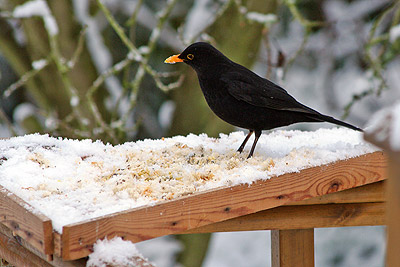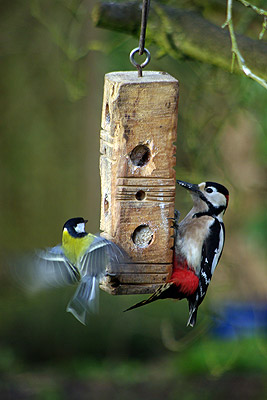
Bird Feeders
bring wild
birds to your garden and help them get through the hard winter days
The North wind doth blow and we shall have snow, and what will poor robin do then?
If he's got anything about him he'll be heading down to a back garden not too far away to avail himself (or herself) of the delicious, high energy food put out by the householder so they can watch garden wildlife close up and turn winter bird food into bird song later in the year.
Wild birds in the garden can be a constant source of entertainment and delight, by enriching their environment, you also enrich yours so you both benefit.
There's lots of food you can put out for the birds, the ubiquitous end of the loaf will bring some birds in to get it, the more finely you break or cut it up the better as it will allow more species to get it. If you have a bird bath you may get corvids (magpies, rooks, crows, jackdaws) using their superior brain power to pick it off the lawn and drop it into the water first to soften it up and make it easier to swallow. Other left-overs are worth a try (apart from vegetables which tend to get left), in our house the food supply goes: people - dog/cat - bird table - compost bucket. If the leftovers are at all edible the chances are there will be something that will eat them.
Birds need high energy food, they can't afford to fly around with heavy, slow to digest food like vegetables, generally, the smaller the bird the more easily digestible (quick through the system) and higher energy food they need, this means fats, oils and proteins. Buy high energy bird food
To get a wider variety of birds, you need to put out a wider variety of food and have some patience, it takes them time to find it and then remember to come back and get into the habit of returning. Putting out food in different kinds of feeders is important too if you want to attract a variety of species otherwise the larger more common types will just turn up in numbers and scoff the lot.
Smaller birds are more acrobatic and can hang on to small perches and access food that larger species cannot get to. Once you've started you will learn which birds are attracted to your garden and which feeders and kinds of food, so adapting to their needs, as time goes by you will see new species turn up and you will see the species balance change as the seasons progress.
A bird table is the obvious starting point, I've found the most effective is a hanging table about 30cm x 45cm, with a lip around the edge to stop the food falling off, though with a couple of gaps to aid cleaning, a 12"� wooden post attached to the middle with a hook on enables it to be hung from a tree or hanging basket bracket on a fence post. Birds don't like rooves over the table (however attractive you might find them) they like to be able to see all around them in case of predators.
Hanging seed feeders or containers for fat/suet balls are excellent too, ideally hung from a tree if you have one. This time the birds prefer it if it is hung towards the middle of the tree as they can still see through the branches, especially in winter, but feel protected particularly when they are focusing on getting food. Experimentation of position is the key to find where is the more effective position. If you don't have a suitable tree metal poles that can be driven into the ground with hooks for feeders to hang from are available, or again use a bracket on a fence post. Buy bird feeders and feeding stations
Near the house or not? You'll want to see your birds when they come to the feeders as that's half the fun, but some are more nervous than others and will take off if they see you through the windows near to them, whereas others are more exhibitionist. Again a bit of experimentation will find the best place for their comfort and your viewing. They will be bolder when it's cold and when they are hungry so frosty mornings or the morning after a very cold rainy night tend to be much busier.
Predictability helps, one feeder kept constantly filled will mean the birds know where to come and so will turn up more regularly than feast or famine feeding when they get out of the habit. Don't forget to clean your bird table and feeders too, it can be very easy to forget about this and just keep topping them up, but like any eating utensil, they will get dirty and if you don't take them down for a good scrub every now and then, they can become sources from where disease can spread.
What turns up will depend on where you live, you will probably get more variety in the countryside than in the city of course. You can expect blue, great and long tailed tits to turn up almost anywhere, individually in the nesting season or in small groups of half a dozen or so out of the breeding season, especially in the winter. Then pretty soon you'll want a small bird identification book ....and a small pair of binoculars by the window to get a better look at that unusual bird that has turned up ... it can get addictive!
Copyright 2000 - present. All Rights Reserved | Privacy Policy Statement


